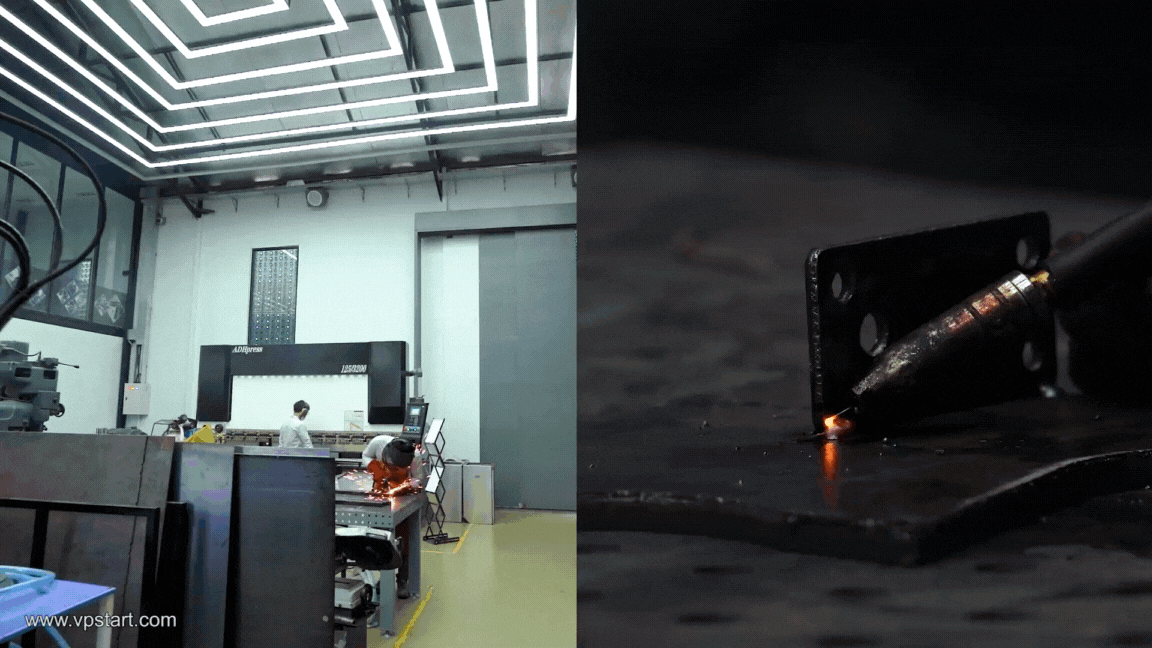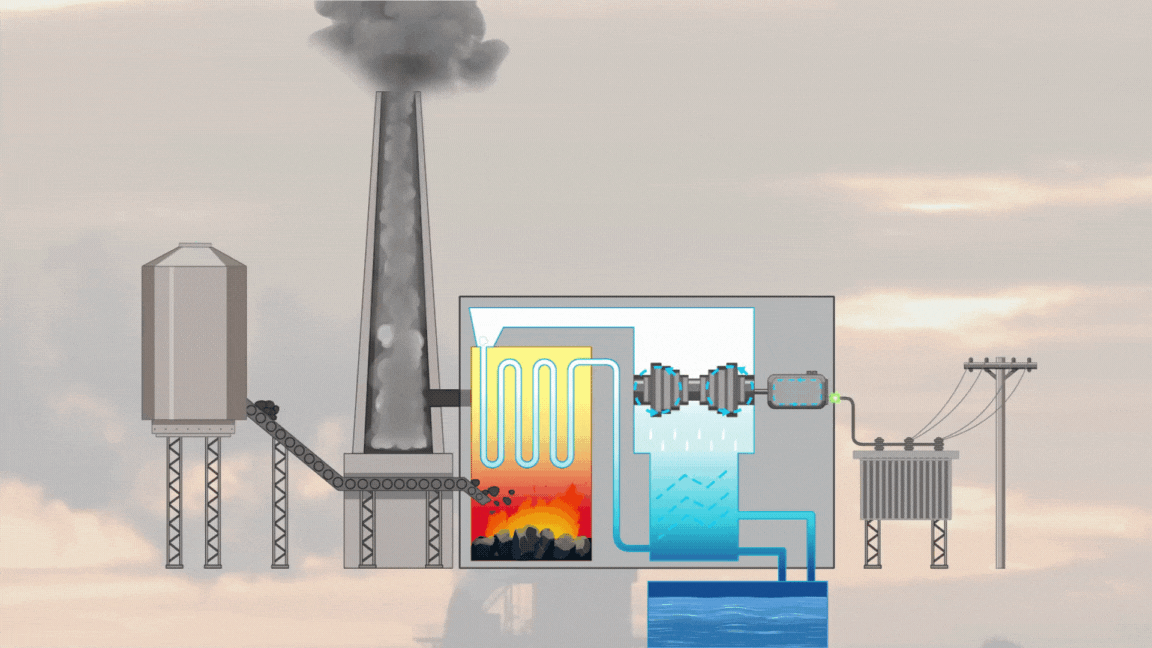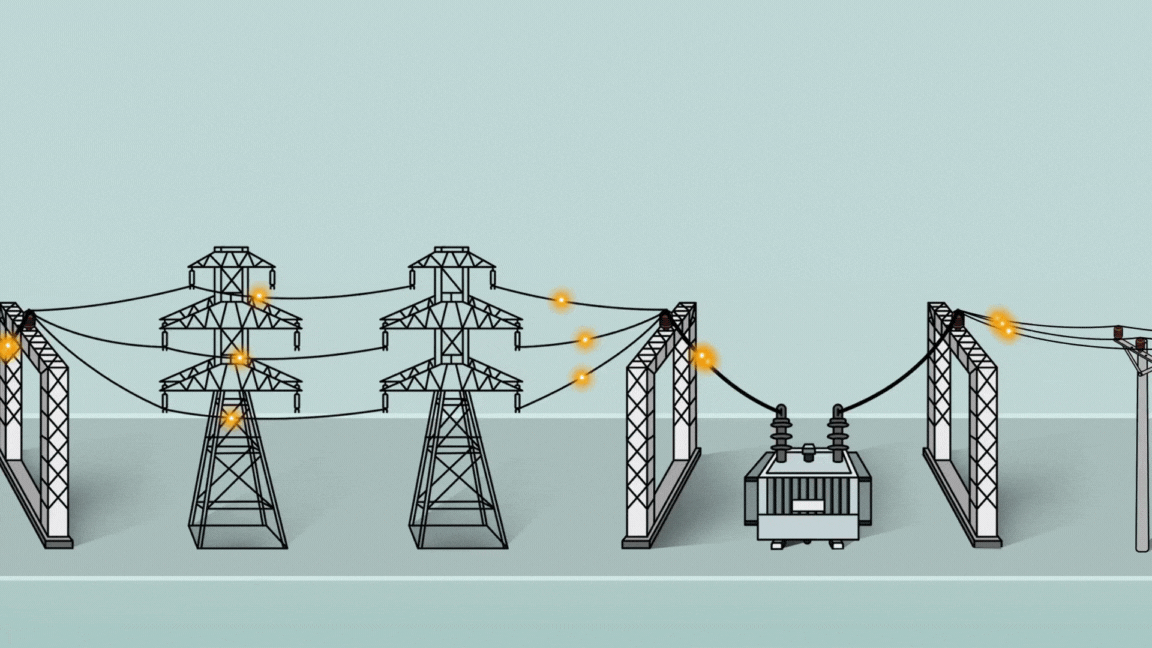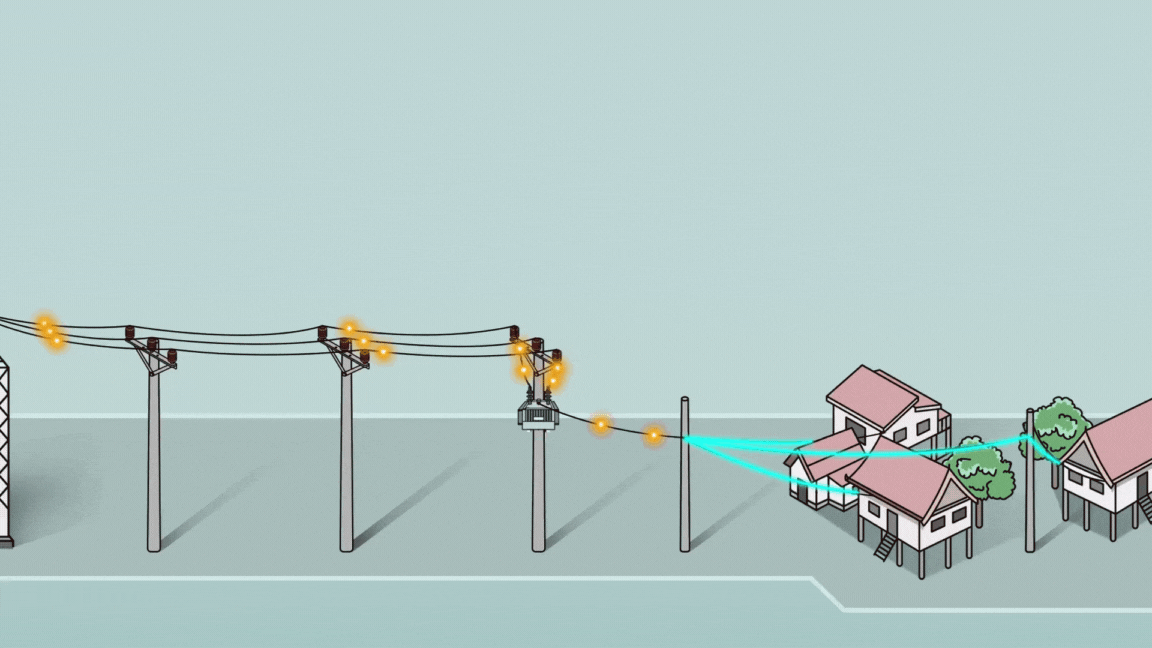07-Sep-2023 |
Getting to Know the Electrical Grid
1. Electricity Generations:
Electricity is an essential component of modern life, powering homes, factories, businesses, and urban infrastructure nationwide.
So, what resources are used to generate electricity, and how is it delivered to consumers?

Electricity is typically generated at power plants. There are various types of power plants, including fossil fuel-based (coal, natural gas, and oil), nuclear, renewable energy (wind power, hydroelectric, solar, biomass, and geothermal). Each type of power plant uses different methods to produce electricity. For example, fossil fuel plant burn fuel to generate steam, which drives turbines connected to generators. Renewable energy sources like wind use turbines to convert natural energy into electricity.

2. High Voltage Transmission Lines
After electricity is generated, it undergoes a process called voltage transformation using step-up transformers. These transformers increase the voltage from the initial level, typically around 7kV, to higher voltages such as 115kV, 230kV, or 500kV (varied on different countries). This step-up in voltage is crucial for efficient transmission of electricity over long distances. High Voltage Transmission Lines, often observed as tall poles stretching across mountains and fields, are used for this purpose. By transmitting electricity at high voltages, power losses during transmission are minimized, ensuring more efficient and reliable delivery of electricity to distant locations.

3. Medium Voltage Distribution Lines
Subsequently, substations are established to lower the high voltage received from the transmission lines to an appropriate voltage level for distribution. In Cambodia, common voltage levels for distribution are 22kV and 35kV. The electricity is then distributed through a network of distribution lines. These lines carry electricity at medium voltage and are typically supported by utility poles, which are visible throughout the country's landscape. However, in urban areas, underground power lines are utilized to distribute electricity, ensuring a clean and aesthetically pleasing cityscape.

4. Low Voltage Distribution Lines
To make electricity usable for consumers, step-down transformers are installed near their locations. These transformers decrease the medium voltage to a low voltage for household or industrial use. In Cambodia, the standard low voltage commonly used range from 220V to 380V, depending on the specific requirements of the consumers' needs.

5. Demand Response:
It is evident that the electricity we utilize in our daily lives goes through various stages, including generation, transmission, distribution, and consumption. The global demand for electricity is continuously rising to meet the needs of people worldwide. However, this increasing demand for electricity has led to a higher reliance on fossil fuels, which has detrimental effects on the planet's climate. To address this issue, there is a global shift towards generating electricity from renewable sources such as wind, solar, and hydropower, biomass, and geothermal. These natural sources of electricity offer a more sustainable and environmentally friendly alternative to fossil fuels.
6. Matters of Utilities:
The distribution of electricity to consumers is often accompanied by various challenges and issues. These problems can arise from natural disasters, such as thunderstorms, as well as human-related incidents, including accidents involving high-speed vehicles colliding with electrical poles, tree-related incidents where trees are cut or fall onto electrical lines, and equipment failures leading to power supply disruptions.
These issues pose significant concerns for utility companies as they result in unstable electricity supply. The consequences of such instability extend to consumers, the revenue of energy providers, and ultimately, the overall development of the country.

Learn more about the fundamentals of electrical grid:
https://youtu.be/db8uy9E2SJU?si=2UN61iOrQenuxWtS
Tel: 098555589 / 023888167
Email: info@vpstart.com / sale@vpstart.com
OTHER News
-
DRCs: Cambodia’s Innovation for the Future of Smart Grid 02-Dec-2025 |
-
VP.Start Completes RPM Grid Upgrade in Four Provinces 27-Nov-2025 |
-
Sharing the SIMA Journey in Berlin 24-Nov-2025 |
-
VP.Start: Bringing Global Connectivity to the Future 24-Nov-2025 |
-
The Power of Connectivity: VP.Start’s Global Mission 22-Nov-2025 |
-
Cambodian Innovation for Global Sustainability 19-Nov-2025 |
-
What can school give you? 19-Nov-2025 |
-
What can't school give you? 19-Nov-2025 |
-
VP.Start is a company of Cambodian Innovation 19-Nov-2025 |
-
Strengthening Collaboration Through Communication 18-Nov-2025 |
-
Transforming the Future Through Collaboration 18-Nov-2025 |
-
Cambodian Innovation for Global Sustainability 15-Nov-2025 |
-
Building Trust Through Every Connection 15-Nov-2025 |
-
DRC-001: Empowering the Future of Grid Modernization 15-Nov-2025 |
-
VP.Start: Where Technology Never Stops Evolving 08-Nov-2025 |
-
What is your SIMA Journey? 08-Nov-2025 |
-
What will VP. Start's BOX become in the near future? 08-Nov-2025 |
-
What Future do you want to create? Why? 08-Nov-2025 |
-
What is the Power of Innovation? 08-Nov-2025 |
-
Stay Curious. Stay Playful. Stay Innovative 05-Nov-2025 |
-
Empowering Growth Through Innovation 30-Oct-2025 |
-
We Speak Innovation to Inspire Change 22-Oct-2025 |
-
Enhancing Current Balancing Efficiency with the LMS 22-Oct-2025 |
-
Stop Selling. Start Listening 11-Oct-2025 |
-
Which do you want to become? 10-Oct-2025 |
-
I Saw the Future, and I Have Hope 10-Oct-2025 |
-
How to Become an Innovator 10-Oct-2025 |
-
The Power of Innovation Through Technology 10-Oct-2025 |
-
Why do we need the DRC? 09-Oct-2025 |
-
Data Beyond Technology: The Evolution of Intelligence 09-Oct-2025 |
-
Together Toward an Intelligent and Sustainable Future 04-Oct-2025 |
-
Small Country, Big Innovations 01-Oct-2025 |
-
Revolutionizing Energy Distribution with RPM Grid-AP 20-Sep-2025 |
-
Innovation Belongs to Everyone 17-Sep-2025 |
-
RPM Grid-AP Training for VP.Start Staff 13-Sep-2025 |
-
VP.Start: Driving Innovation for a Sustainable Future 10-Sep-2025 |
-
VP.Start: Innovation That Drives Global Impact 10-Sep-2025 |
-
What Makes the RPM Grid-AP Stand Out? 08-Sep-2025 |
-
What Is the Role of the RPM Grid-AP? 08-Sep-2025 |
-
RPM Grid-AP A Revolutionary Smart Grid Management System 06-Sep-2025 |
-
The Evolution of DRC: From Birth to Breakthrough 03-Sep-2025 |
-
RPM Grid-AP 29-Aug-2025 |
-
DRC-003: A Missing Link for the Smarter Grid 29-Aug-2025 |
-
A Revolutionary Solution for the Grid Transformation 27-Aug-2025 |
-
A Consumer-First Philosophy at VP.Start 27-Aug-2025 |
-
Issues, Solutions, Impacts: The Power of EcoGrid 27-Aug-2025 |
-
Commissioning RPM Grid-AP for EDC 27-Aug-2025 |
-
Innovation! 21-Aug-2025 |
-
What Makes DRC-003 a Powerful Tool in Energy Management? 21-Aug-2025 |
-
How Does DRC 003 Respond to Powerline Faults? 21-Aug-2025 |
-
DRC-003 A Watchful Guardian for Auto Recloser 21-Aug-2025 |
-
How Does DRC-003 Reduce Operational Costs? 19-Aug-2025 |
-
The Uniqueness of DRS 14-Aug-2025 |
-
Why Do Utilities Need to Use DRS? 14-Aug-2025 |
-
What Will the DRC- 012G Become in the Future? 12-Aug-2025 |
-
DRC-012G A Game-Changer for Energy Meter Management 10-Aug-2025 |
-
Why Did VP.Start Develop the DRC-012G? 06-Aug-2025 |
-
What Makes the DRC-012G Outstanding? 06-Aug-2025 |
-
What Challenges Can the DRC-012G Tackle? 06-Aug-2025 |
-
The Roles of the DRC-012G in Energy Meter Management 06-Aug-2025 |
-
How Can the DRC-012G Enhance Energy Efficiency? 06-Aug-2025 |
-
DRS Reduces Energy Losses 03-Aug-2025 |
-
How Does DRS Revolutionize Meter Management? 03-Aug-2025 |
-
Why Did VP.Start Create DRS? 03-Aug-2025 |
-
Why does VP.Start need to go international? 31-Jul-2025 |
-
What Is the Green Innovation of VP.Start? 30-Jul-2025 |
-
How Does DRC-004G Contribute to Combating Climate Change 30-Jul-2025 |
-
Key Roles of the DRC-004G in Metering Management 26-Jul-2025 |
-
How Does DRC-004G Optimize Energy Efficiency? 23-Jul-2025 |
-
What Challenges Can the DRC-004G Address? 23-Jul-2025 |
-
How do we create a high-quality solution at VP.Start? 20-Jul-2025 |
-
What Are The Key Features Of The DRC-018? 20-Jul-2025 |
-
What Is DRC-018? 18-Jul-2025 |
-
How Can DRC-018 Streamline Operations? 18-Jul-2025 |
-
DRC (Distribution Remote Control) 14-Jul-2025 |
-
What builds our momentum and moves us forward? 14-Jul-2025 |
-
What makes our journey work? 14-Jul-2025 |
-
How Can We Reach Our Goal If We DON'T START NOW? 14-Jul-2025 |
-
VP.Start Expert Engineer Presents LMS at EDC Takeo 10-Jul-2025 |
-
VP.Start Expert Engineer Presents LMS to EDC Kampot 10-Jul-2025 |
-
VP.Start’s Eco-sustainable System for the Future 08-Jul-2025 |
-
DRC-006 Is an Eco-solution for Grid Modernization 08-Jul-2025 |
-
DRC-006 Optimizes Efficiency and Reduces Losses 08-Jul-2025 |
-
How Does the DRC-006 Make Benefits for Utilities 08-Jul-2025 |
-
What Can Utilities Do with DRC-006? 05-Jul-2025 |
-
DRC-006 ls Designed to Streamline RTUs Operations 05-Jul-2025 |
-
DRC-009 An Eco-Solution Designed for Ring Main Units 03-Jul-2025 |
-
DRC-009 Streamlining Operations 03-Jul-2025 |
-
How is DRC-009 Operated? 03-Jul-2025 |
-
RPM Grid-AP One Platform to a Nationwide Control System 03-Jul-2025 |
-
How Does DRC-009 Make Benefits for Utilities? 29-Jun-2025 |
-
The Power of the Circle 28-Jun-2025 |
-
What Challenges Can DRC-015 Address? 19-Jun-2025 |
-
How Can the DRC-015 Make Benefits for Utilities? 19-Jun-2025 |
-
How Can the DRC-002 Streamline Grid Operations? 14-Jun-2025 |
-
What Are the Powerful Features of DRC-002? 14-Jun-2025 |
-
What Is the Next Version of the DRC-002? 14-Jun-2025 |
-
A Vigilant Reporter Transmitting Data to LMS 14-Jun-2025 |
-
What Dose It Really Mean to be Data-diven? 12-Jun-2025 |
-
What Are the Roles of DRC-002 in Modern Grid Management? 12-Jun-2025 |
-
What is your Endless Journey? 09-Jun-2025 |
-
What Makes You Different? 09-Jun-2025 |
-
What Moves You Forward? 06-Jun-2025 |
-
What Drives You a Story? 05-Jun-2025 |
-
VP.Start in the Sustainable Smart City Workshop 04-Jun-2025 |
-
What Makes NiteLite System Standout? 01-Jun-2025 |
-
NiteLite Enhances EnergyEfficiency 01-Jun-2025 |
-
NiteLite Increases Cost Efficiency 01-Jun-2025 |
-
What Will DRC-001 Look Like in the Future? 31-May-2025 |
-
How Can the DRC-001 Make Return on Investment? 29-May-2025 |
-
The Spirit of Relentless Growth 29-May-2025 |
-
The 3 Outstanding Features Of AlienCheck 28-May-2025 |
-
DRS Enhances Power Quality 28-May-2025 |
-
What Is the Next Version of LMS? 28-May-2025 |
-
The Innovation Behind the DRC-015 in Modern Grid Systems 28-May-2025 |
-
AlienCheck: Universal Connectivity Network (UCN) 28-May-2025 |
-
Instant Alarm for Anomalies on the Powerlines 22-May-2025 |
-
Seamless Remote Control Capability 17-May-2025 |
-
Streamline Electrical Grid Management 17-May-2025 |
-
Reduce Operational Costs and Improve Energy Efficiency 16-May-2025 |
-
RPM Grid-AP 10-May-2025 |
-
PLUM App (Power Line Utility Management) 10-May-2025 |
-
VP.Start Presentation on DRS for EDC Mondulkiri 08-May-2025 |
-
VP.Start Presentation on DRS for EDC Ratanakiri 07-May-2025 |
-
VP.Start Presentation On DRS to EDC Kratie 06-May-2025 |
-
The SIMA Journey – our ideology 02-May-2025 |
-
What does VP.Start believe? 02-May-2025 |
-
DRS (Advanced Metering management System) 02-May-2025 |
-
RPM Grid System (Remote Power Medium Voltage Grid) 02-May-2025 |
-
How Can We Harness Data for a Sustainable Future? 23-Apr-2025 |
-
The Smart City Presentation to Takeo Provincial Governor 08-Apr-2025 |
-
VP.Start’s CEO Visited EDC Kampong Cham 12-Mar-2025 |
-
VP.Start’s CEO Visited EDC Tboung Khmum 12-Mar-2025 |
-
VP.Start’s CEO Visited Electric Licensees 20-Feb-2025 |
-
VP.Start’s CEO Visited EDC Siem Reap 19-Feb-2025 |
-
VP.Start’s CEO Visited EDC Sihanoukville 18-Feb-2025 |
-
VP.Start’s CEO visited ELECTRICITE DE BATTAMBANG 12-Feb-2025 |
-
VP.Start Visited Electricity of Bateay Meanchey 12-Feb-2025 |
-
DRS Presentation for EDC Takeo 07-Feb-2025 |
-
VP.Start's BOX Engineering Day 2024 at RUPP 26-Oct-2024 |
-
MISTI Visits VP.Start Campus to Explore New Technologies 10-Sep-2024 |
-
VP.Start Visits North Star Group in Hanoi, Vietnam 06-Sep-2024 |
-
Sustainability Recognition Award 31-Aug-2024 |
-
Proudly Cambodia, Boldly International 06-Aug-2024 |
-
Why VH-012-1C is the Best Choice for a Smart Home? 22-Jul-2024 |
-
The Presentation of DRC Solutions to EDC Takeo 26-Jun-2024 |
-
Presentation at Borey Peng Huoth Boeung Snor Community 11-Jun-2024 |
-
GRID CALCULATION, License Men Khunthea 11-Jun-2024 |
-
The 9th GEE Family Reunion at ITC 08-Jun-2024 |
-
Presentation at CHIP MONG 271 04-Jun-2024 |
-
The Objective for Enhancing Pedagogy (OEP) 30-May-2024 |
-
The Visit and Presentation to EDC Takeo 28-May-2024 |
-
The Visit to the Huawei Technology (Cambodia) office 21-May-2024 |
-
Baksey Media (Technology Cambodia) 26-Apr-2024 |
-
Visit by the World Bank Group 03-Apr-2024 |
-
Visited to ENTEC foreclosure 16-Mar-2024 |
-
Visited LS Electric and PECC2 14-Mar-2024 |
-
Why Needs to Update the Conventional Grid to Smart Grid? 09-Jan-2024 |
-
GRID CALCULATION, License Vorn Virak Services 21-Dec-2023 |
-
Bro Tip Project for "Ministry of Mines and Energy" 25-Nov-2023 |
-
Balancing the Grid 22-Nov-2023 |
-
What Is RPM Grid? 24-Oct-2023 |
-
Industry 4.0 in Cambodia at the ASEAN Factori 4.0 25-Aug-2023 |
-
Presentation to EDC Banteay Meanchey 15-Mar-2023 |
-
Presentation to EDC Siem Reap 14-Mar-2023 |
-
Presentation to EDC Stung Treng 28-Feb-2023 |
-
Presentation to EDC Kampong Cham 23-Feb-2023 |
-
Presentation to EDC Svay Rieng 21-Feb-2023 |
-
Business Presentation to EDC Kampot 07-Feb-2023 |
-
Business Presentation to EDC Mondul Kiri 25-Jan-2023 |
-
Business Presentation to EDC Kratie 24-Jan-2023 |
-
Presentation EDC Tboung Khmum 23-Jan-2023 |
-
Presentation DRC-006 to DCC of EDC Phnom Penh 01-Nov-2022 |
-
Basics of Distribution Grids & Managing Grid Stability 12-Oct-2022 |
-
Street Light Presentation at Kandal Province Hall 26-Aug-2022 |
-
Business Presentation and Visit in Malaysia 13-Aug-2022 |
-
Presentation Street Light at Kandal Province 28-Jun-2022 |
-
Business Presentation to EDC Phnom Penh, DCC 30-Mar-2022 |
-
5 Ways To Reduce Your Electricity Bill 23-Sep-2021 |
-
Presentation DRC-009 to DCC of EDC Phnom Penh 05-Jan-2021 |
-
Celebrating 6 Years of Achievements & The New Year 2021 30-Dec-2020 |
-
Presentation to Rural Electrification Fund 09-Dec-2020 |
-
Presentation to EDC Bunteay Mean Chey 03-Dec-2020 |
-
Presentation to Business and Distribution Department 29-Sep-2020 |
-
Department of Rural Electrification Fund 09-Sep-2020 |
-
Presentation to EDC Ratanakiri 21-Jun-2020 |
-
Presentation to EDC Tbong Khmom 04-Jun-2020 |
-
Presentation to EDC Kampot 07-May-2020 |
-
Presentation to EDC in Phnom Penh City 23-Jul-2019 |
-
Sales Team Presents To The EDC at Svay Rieng 20-Dec-2018 |
-
Presentation to EDC Kratie 20-Jun-2018 |
-
EDC Tbong Khmum Presentation 03-May-2018 |
-
Siemens Team Visit at VP.Start 02-Feb-2018 |
-
Presentation to BVC Power 01-Jan-2018 |
-
EDC Kampot Presentation 19-Jul-2017 |
-
Business Presentation to EDC Kampong Speu 17-Jul-2017 |
-
Presentation to EDC Battambang 23-Nov-2016 |
-
Presentation to EDC Kampong Cham 04-Nov-2016 |
-
Presentation to Electricity of Sihanouk Province 26-Oct-2016 |
-
Business Presentation to EDC Siem Reap 18-Oct-2016 |